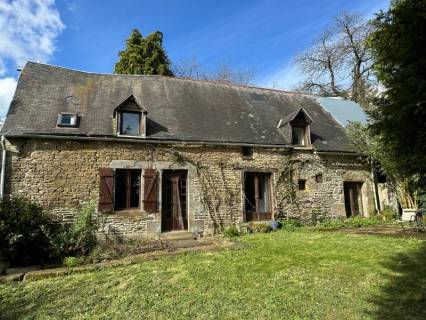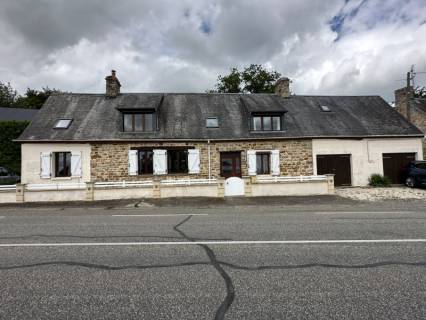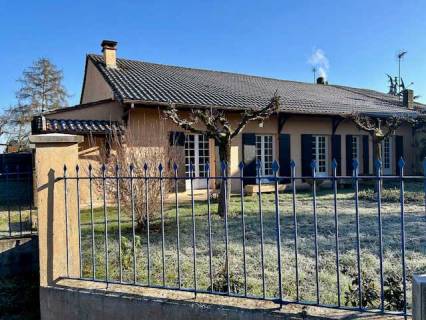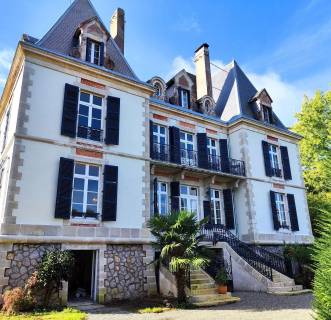Jan 052021

One of the many things we associate with France, along with wine, has to be cheese. With no fewer than 650,000 dairy farms throughout France, and a whopping 20 kg of cheese consumed per capita, per year, the French really do take their cheese seriously. As President Charles de Gaulle famously said in 1962, ‘How can you govern a country which has 246 varieties of cheese?’
These days, in fact, there are more like 1000 varieties of popular French cheeses, mainly classified into eight categories known as ‘les huit familles de fromage.’ They are:
- Pressed (or hard) Cheese (Fromages à Pate Pressée)
- Pressed and Cooked Cheese (Fromages à Pate Pressée et Cuite)
- Goat Cheese (Fromages de Chèvre)
- Blue Cheese (Fromages à Pate Persillées)
- Soft Cheese with Natural Rind (Les Fromages à Pâte Molle et à Croûte Fleurie)
- Soft Cheese with Washed Rind (Les Fromages à Pate Molle et à Croute Lavée)
- Processed Cheese (Fromages à Pate Fondue)
- Fresh Cheese (Fromages Frais)
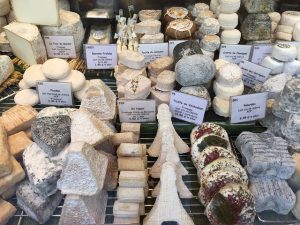 French cheese production can be categorized into four types:
French cheese production can be categorized into four types:
- Fermier: Made from milk produced on the same farm
- Artisanal: Produced in small quantities using farm milk or milk from local farms
- Cooperative: Local milk producers working together to produce cheese
- Industriel: Factory produced cheese
Each of France’s thirteen metropolitan regions produces widely varying cheeses, so let’s look at some of the main ones here:
Brittany
With a vast coastline spanning the north-west region of France, Brittany is best-known for its fresh seafood, but its incredibly fertile soil and temperament climate also makes it ideal for agriculture, and with almost 16,000 dairy farms, Brittany produces a fifth of France’s overall milk production.
- Saint-Paulin – a creamy soft cheese with an orange rind and a sweet, buttery taste.
- Cure Nantais – created by a priest in 1880 in a small village near Nantes, Cure Nantais is a soft, rind-washed cow’s milk cheese aged on spruce boards in a wet basement.
Normandy
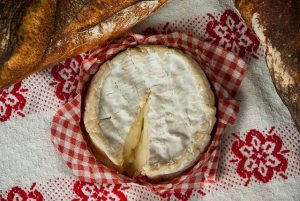
Camembert
A predominantly agricultural region with cattle breeding its most important sector, it is little wonder that Normandy leads France in cheese production.
- Camembert – one of France’s most famous and best-loved cheeses, this soft, bloomy rind cheese was created in the late 18th century in the village of Camembert in Orne. Often compared to Brie, its aroma is more pungent and its flavour is stronger, slightly more sour and chalky. A ripe Camembert should be soft on the inside, but not too runny.
- Pont l’Eveque – one of Normandy’s oldest cheeses, this creamy soft cheese, uncooked and unpressed, was created in the 12th century by Cistercian monks in the coastal region south of Deauville.
- Livarot – named after its birthplace, this is a soft, pungent, washed rind cheese made from cow’s milk. Popular among nobles in the late 17th century, it is sold with three strings of wood surrounding its crust.
- Neufchâtel – this heart-shaped cow’s milk cheese has been made since the 7th century, and legend has it that in the 10th century, French girls would offer it to English soldiers as a token of their love.
Hauts de France
Made up of fertile farmlands, this region has a rich history in agriculture.
- Maroilles – this soft rind-washed cheese is one the oldest in France, first recorded in the 7th century and enjoyed by a long list of French royalty. It was known in the Middle Ages under the name Craquegnon. It has a sweet and citrusy flavour and a strong and pungent aroma.
Centre-Val de Loire
As well as the famous Loire valley chateaux, this area includes forests, gentle hills and valleys, and produces two fine goat’s cheeses.
- Selles-sur-Cher – this Berrichon cheese made with goat’s milk dates from the 19th century, and is soft, with a rind that is salted and ashed with charcoal, giving it a sweet, hazelnut flavour.
- Crottin de Chavignol – first recorded in the 16th century, thanks to its small, dry texture it is named after goat’s droppings, but is widely used in goat’s cheese salad.
Ile de France
Beyond Paris, one of France’s most famous cheeses is produced in the rolling countryside of Seine-et-Marne, where 60% of the region is farmland.
- Brie de Meaux and Brie de Melun – this mild, creamy cheese was referred to by King Charlemagne in 774, and Louis XIV is said to have eaten it every day. Both types of Brie are named after towns some fifty miles south-east of Paris. The Brie de Meaux is refined for 4 to 8 weeks, the Brie de Melun for up to 12 weeks. The Brie de Meaux is moulded with a shovel and the Brie de Melun with a ladle. The Brie de Melun is slightly smaller of the two. In 1793, magistrate François Joachim Esnue-Lavallee said, ‘the Brie, loved by rich and poor preached equality before we ever imagined it possible’.
- Coulommiers – production began in the early Middle Ages in the village of the same name, and like its cousin Brie, it has a soft yet compact texture, with a lighter taste than Camembert.
Grand-Est
Located in the north-eastern region of France, and boasting two mountain ranges – Vosges and Ardennes – this region shares borders with Belgium, Luxembourg, Germany and Switzerland.
- Munster – a fairly strong soft, rind-washed cheese, composed of raw cow’s milk. Created in the 7th century by monks in the Vosges mountains, it comes in two varieties, normal and au cumin, or with cumin seeds.
-
Langres – first mentioned in the mid 18th century, the Langres is never flipped during production, hence a small basin-style dent at its top. The deeper the basin, the more aged the cheese.
Burgundy-Franche-Comté
Located on the border with Switzerland, this is a region made up of beautiful fields, luscious forests and majestic mountains. It also produces a wide variety of cheese.
- Délice de Bourgogne – a soft-ripened triple-creamed cheese, creamy and smooth, with an extremely bloomy and pungent rind.
- Bleu de Gex – only ever produced from the milk of the Montbéliard cow, this has a creamy, semi-soft texture and its rind is always stamped with the word Gex.
- Comté – a French cousin to the Swiss Gruyère, this famous dry, cooked cheese was created in the early Middle Ages. It is produced collectively by villages along the Swiss border, and all milk comes from cows grazing at at least 400 metres altitude. It comes in different varieties, sometimes called fruité or salé (fruity or salty). Fruité Comté is more elastic; salé more brittle. The most expensive Comté is Comté vieux (old Comté), generally aged between six months to a year. As it ages, its taste gets stronger, with a saltier and nuttier aftertaste, and it is the traditional cheese used in fondue and raclette.
- Mont d’Or – this soft rind-washed cheese, known as Vacherin in Switzerland, has been made since 1280 along the French-Swiss border at altitudes of 800 metres. It is matured in a round frame made of local spruce wood, which imparts a specific aroma, and is then packaged and sold in round boxes of the same wood. It has an undulating beige crust, under which the cheese is soft to runny, with a light woody and nutty taste.
- Epoisses – Burgundy’s most famous cheese was created in the 16th century by Cistercian monks in the village of Epoisses. Enjoyed by Louis XIV and Napoleon, it is a soft, rind-washed cheese that is very strong smelling.
Auvergne-Rhônes-Alpes
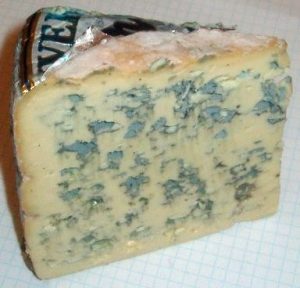
Bleu Auvergne
Situated in the centre of the Massif Central, this region features volcanic mountains, rugged countryside and rocky gorges.
- Bleu d’Auvergne – a cow’s milk, blue-veined cheese created in the 19th century by farmer Antoine Roussel, who wanted to make a ‘bluestain’ cheese with a ‘special, pleasant and perfumed’ taste. Specific varieties of Bleu d’Auvergne include the ancient Bleu de Laqueille.
- Saint-Nectaire – one of Louis XIV’s favourite cheeses which was created by female farmers in the 17th century. With its slightly woody, nutty flavour and unctuous texture, some claim that it is the greatest of French cheeses, but it varies considerably in quality and taste. There are two distinct types, the farm and the dairy variety, of which the farm variety is generally better and more expensive. A properly matured Saint Nectaire should be soft and elastic, with a tendency to flow if left at room temperature.
- Reblochon – this rich, soft pressed cheese originates from the 13th century in the Thones valley, Haute-Savoie, when farmers start applying ‘the Rebloche’ technique of pinching the cow udders twice for a creamier milk, ideal for cheese. Soft but not too creamy, it has a mild, fruity taste and an intense nutty aftertaste, and is used in many winter recipes such as fondue.
- Cantal – pressed, uncooked cow’s milk cheese and one of France’s oldest cheeses. It can weigh up to 45 kg. Close to an English farmhouse cheddar, it comes in two varieties: jeune and entre deux, meaning cheese that has matured for longer.
- Le Saint-Félicien – a cousin of the Saint Marcellin, traditionally it was made with goat’s milk, but is now mostly from unpasteurized full cow’s milk. Creamy with a buttery and nutty taste.
Nouvelle-Aquitaine
This famous wine-making region is extremely fertile, perfect for dairy farming and cheese making.
- Ossau-Iraty – a pressed, uncooked sheep’s milk cheese, made from the milk of Basco-bearnaise, Manech black head or Manech red head ewes.
- French Edam – first made in 1660 in Queyrac in the Medoc, the red colour of the rind came from the Bordeaux barrels in which the cheeses were shipped.
Occitanie
Comprising the Midi-Pyrenees and Languedoc Roussillon, this area boasts a wide diversity of agricultural land and production, and its fertile coastal plain is given over to agriculture, vineyards, fruit and vegetables.
- Bleu des Causses – a classic blue cheese, comparable to Roquefort, with a pungent mushroom-like aroma and blue-grey mould, giving this cheese a strong essence of traditional blue cheese.
- Laguiole – a hard cheese originating in monasteries in the Aubrac mountains, which has a firm texture that crumbles and a buttery flavour.
- Roquefort – the most famous French blue cheese, which came about, according to legend, when a loved-up shepherd left his sandwich of rye bread and ewe cheese in a cave to go and see his mistress. On his return it had grown mouldy, and the Roquefort was born. Made in the Causses mountains in Aveyron using locally-sourced milk of the Lacaune breed of sheep, it is still matured in caves. Over 18,000 tons of Roquefort are produced each year, and it is exported worldwide.
- Pelardon des Cevennes – the name of this soft, bloomy rind goat cheese originated from the Cevenol language ‘pebre’ meaning pepper. In 1756, the abbot Boissier de Sauvage wrote of a cheese called Peraldou ‘little rounded and flat cheese we make in the Cevennes…’ Occitan writer Frederic Mistral described it as a “little rounded cheese, goat’s milk, spicy and dry taste, and proper to Cevennes”. Its final Pelardon name was established in the 19th century.
- Cabecou d’Autan – a soft, bloomy rind goat cheese from Poitevine, Saanen or Alpine goats, raised in the Quercy and Rouergue regions. A south-west product, its name comes from the Occitane language ‘cabra’ (goat) and ‘fromatjon’ (little cheese).
- Cabécou de Rocamadour – dating back to the Middle Ages, this cheese has a lighter flavour than most other goat cheeses.
Provence Alpes Cote d’Azur
More famed for its vineyards, lavender and olive groves than its agriculture, one excellent cheese is produced here in Provence.
- Banon – named after a small village located near the Plateau d’Albion, where shepherds wrapped it in chestnut leaves, held with a blade of raffia. In 1849, abbot Feraud wrote: ‘we run in Banon several attended fairs. The cheese sold there is very valued’.
Corsica
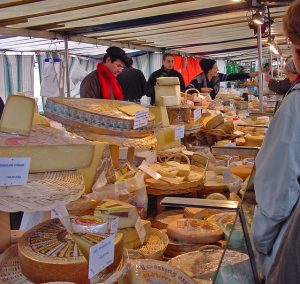
Acclaimed for its mountainous interior and glorious beaches, Corsica also produces a wonderful goat’s cheese.
- Brocciu – the pride of the Ile de Beauté, this is the only cheese made with Corsican ewes’ and/or goats’ whey. Its name stems from the word “brousse” which is a reference to a Provençal fresh cheese. Author Emile Bergerat once wrote of this cheese: ‘The one who never tasted, doesn’t know the island’.
Half the fun of staying or living in France is visiting its markets and trying all the fresh, local produce on view, so why not pick up a new cheese on your next shopping trip – you might make a wonderful new discovery!



